The beast appears, though you didn't expect it. You've never seen anything like this creature, a giant komondor dog with horns--and a former vicar of the church, apparently, evangelizing her faith by holding her paws together in prayer, then slamming them onto the ground and knocking you clear. The vicar is a microcosm of Bloodborne itself, a wondrous monstrosity that attacks you with vicious horror and religious overtones until you submit to it. Even should you rise above its terrors, Bloodborne answers to no master. Instead, you come to an agreement with it: You allow it to invade your brain and demand your concentration, and it allows you to wake from inevitable death, reminding you with each resurrection that life is a gift.
I know: such hyperbole! Yet this is the language of Bloodborne, a Dark Souls game in all but name, and one that introduces new themes and story motifs that cannot be overlooked. Dark Souls and its direct sequel allowed their sights, sounds, and swordplay to tell the most vital tales, relegating backstory to atmospheric tapestries that revealed their details only if you looked closely enough. Bloodborne is not short of mysteries, but its narrative beats are inescapable, and its Christian themes are undeniable. The Souls games led you through parishes and cathedrals, but never have they made such grandiose statements with their subject matter. Now, developer From Software has crafted an extravagant religious parable that mirrors its game's death-and-resurrection mechanics.
The allegory isn't subtle: This is a third-person action role-playing game (or role-playing action game, depending on your view) featuring a cleric and a vicar among its bosses. Outside of this clear theming, the developing saga comes to life through the sights and sounds of its world. One of Bloodborne's many striking images is that of a massive crucified figure surrounded by single-minded worshipers which poison you when they attack. The low, grumbling hum of their chant is as terrifying as their unwavering focus on their deity. Once I discovered a surreptitious way to view their worship from above, I would sneak in just to bathe in the bizarre beauty of the scene. Bloodborne sucks the faith, hope, and charity from religious devotion, populating its world with grotesque disciples and forcing the meek into their homes, from where they hope for the church to cleanse the world of its woes.
This isn't a high-minded reading of Bloodborne's story, which is none too nuanced. In fact, the lack of thematic nuance is what makes From Software's newly introduced storytelling spotlight as successful as it is. Bloodborne is unafraid to go big, to the extent that you may find yourself questioning if what you think is happening is really what's happening. The answer to that is, unequivocally, "yes." As Bloodborne introduces new sights and events, your suspicions become digital reality, and then the game asks you to suspend disbelief once again, rising to ridiculous heights of absurdity. That its malformed majesty works so well is Bloodborne's greatest feat. I wouldn't call its key events story twists, but rather, story detonations; Your expectations aren't subverted but heightened, by many orders of magnitude.
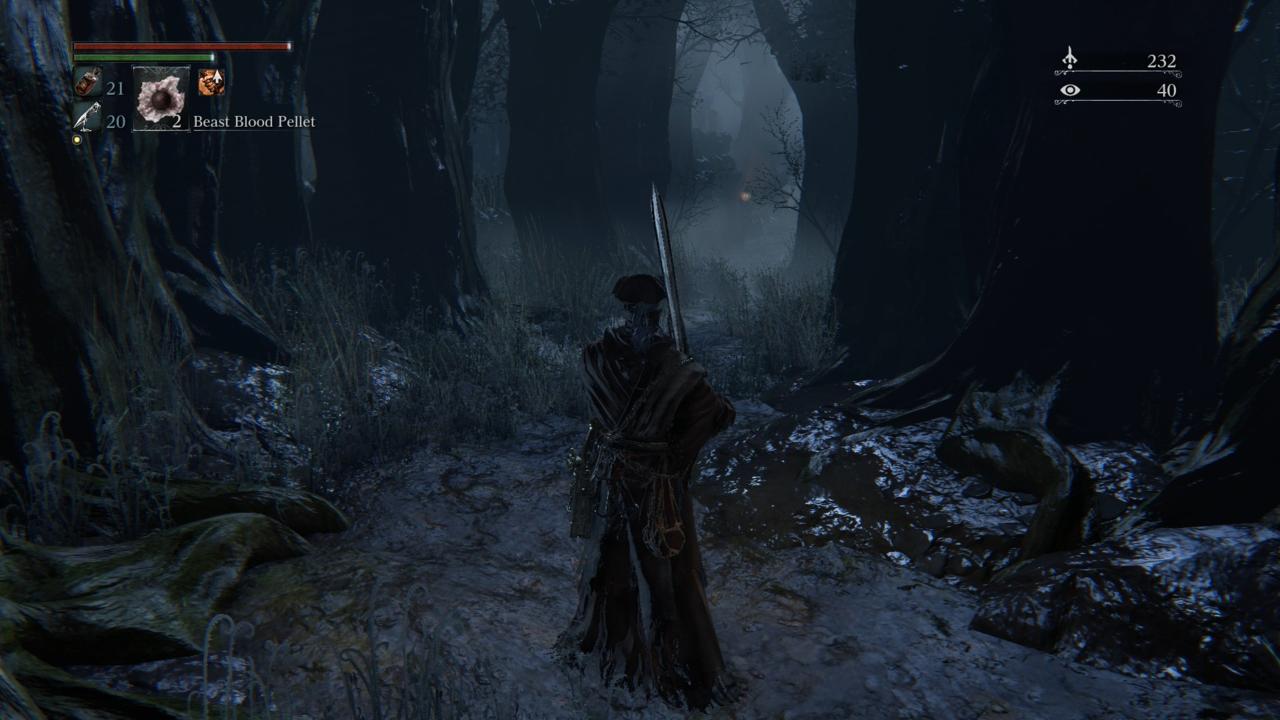

Oh, how I wish I could share with you the details, or at least put some dots on the page and let you connect them. These are discoveries you should make on your own in this excellent game. I offer reassurances, however, that Bloodborne has not taken From Software's template into Elder Scrolls territory. You will not find reams of short stories to read on the game's bookshelves, and you will not be flitting from one non-player character to the next looking for quests. But there are NPCs to chat with, most of whom stay hidden behind doors and respond to your knocks with whimpers for help, maniacal laughter, or tearful pledges to stay true to the church. For that matter, there are scattered pages to find and read, most of which have a simple expository message written on them, or a smidgen of history. With Bloodborne, From Software makes a few nods to modern game design tropes, but the additions are coated with a veneer of poetic surreality.
As with the Souls games, Bloodborne doesn't typically tell you where to go and what to do when you get there. You are given a few vague, overarching goals, but the intricately interconnected regions and pathways, along with nebulous visual cues, lead you to your destination. If you get stuck, it means you are applying video game logic to a game in which that logic doesn't apply. Those scarce lines of dialogue, and those few cutscenes, are not just for atmosphere: They're nuggets of information you should file away in your head and refer to later. And if the signs point to an action that you think violates the rules of video games, you should probably follow them, even when that action previously failed. Bloodborne speaks; It is your responsibility to listen. If an enemy descends upon you from the rafters above, it only stands to reason it must have found a way up there--and it means you can find one, too. It's contextual communication at its most sophisticated.

Thankfully, this world is one worth knowing, and knowing well. You spend the early hours in the city of Yharnam and its surrounding regions, which resemble 19th-century London more than they do the Souls games' dark medieval locales. The "werewolves in Victorian England" setting has been done, but as any Souls player might tell you, you must move deeper into the kingdom before you you can expose its true form. It's difficult not to admire Bloodborne's artistry: the baroque carvings on its stone archways and pillars, the statues depicting the locals' grief and suffering, and the gradual visual evolution of the game's hub area, which is known as Hunter's Dream.
After Bloodborne soaks you in its initial ironworks, it introduces greater graphical diversity. Dark Souls II varied its looks more often, but its regions didn't share an overarching theme: There was the lava area, and the poisonous woods, and so forth. The different places were connected by pathways, but not by a clear visual arc. Bloodborne, on the other hand, tells a story with its environments as you press onward, echoing its plot within its architecture and its enemies. You return to earlier areas to find they aren't as they once were, and the boundary between reality and nightmare becomes fuzzier with each slain boss. The way these areas join together enhance the joys of exploration. You discover a path leading from a swampy cave, which in turn guides you to a series of ladders. At the top of the final ladder, you realize where this path has taken you, and can only marvel at the brilliant way these two places, so seemingly distant from each other, are united.
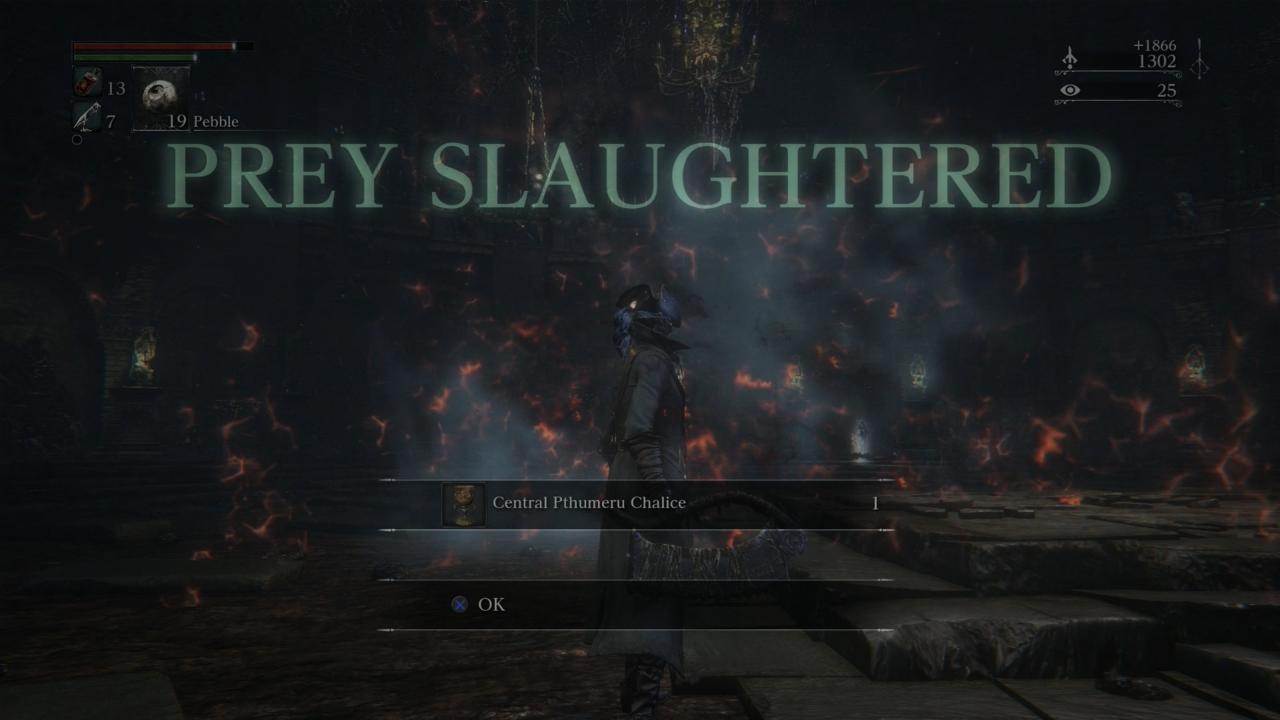
There is a blight on this town in the form of seriously long load times and occasional frame rate foibles, both of which are a shame, given that this is the first Souls-esque game to appear on a current-generation console--and given how performance issues are one of many commonalities these games share. The frame rate jitters aren't common when you play on your own, but become more apparent when others join you for some jolly cooperation. The loading times could have been mitigated by a system that allows you to directly move between lamps you have activated, a la Dark Souls II. Lamps are Bloodborne's save points, which stand in for the Souls games' bonfires, and allow you to transport to Hunter's Dream. You cannot directly teleport from one lamp to another, however: You must always travel to the Dream first, meaning that quick travel requires you to endure not one, but two 30-second loading screens.
Your patience is a price worth paying. Bloodborne is rewarding to play, impressive both in how it cribs from the Souls games as well as in how it deviates from them. Your Souls combat skills apply to Bloodborne, but only to a certain extent. If you relied on a shield to defend you in the past, you won't find the paltry plank you find to be of much use to you. The game demands mobility, not hardiness. Your first steps into the streets of Yharnam lead you to roaming squads of ravaged dogs and torch-bearing cultists, some of whom wield firearms, and whose shots not only damage you, but stagger you as well. Avoidance is imperative, lest a quartet of mutts tear your flesh apart while leaving you powerless to slash your way out of danger.
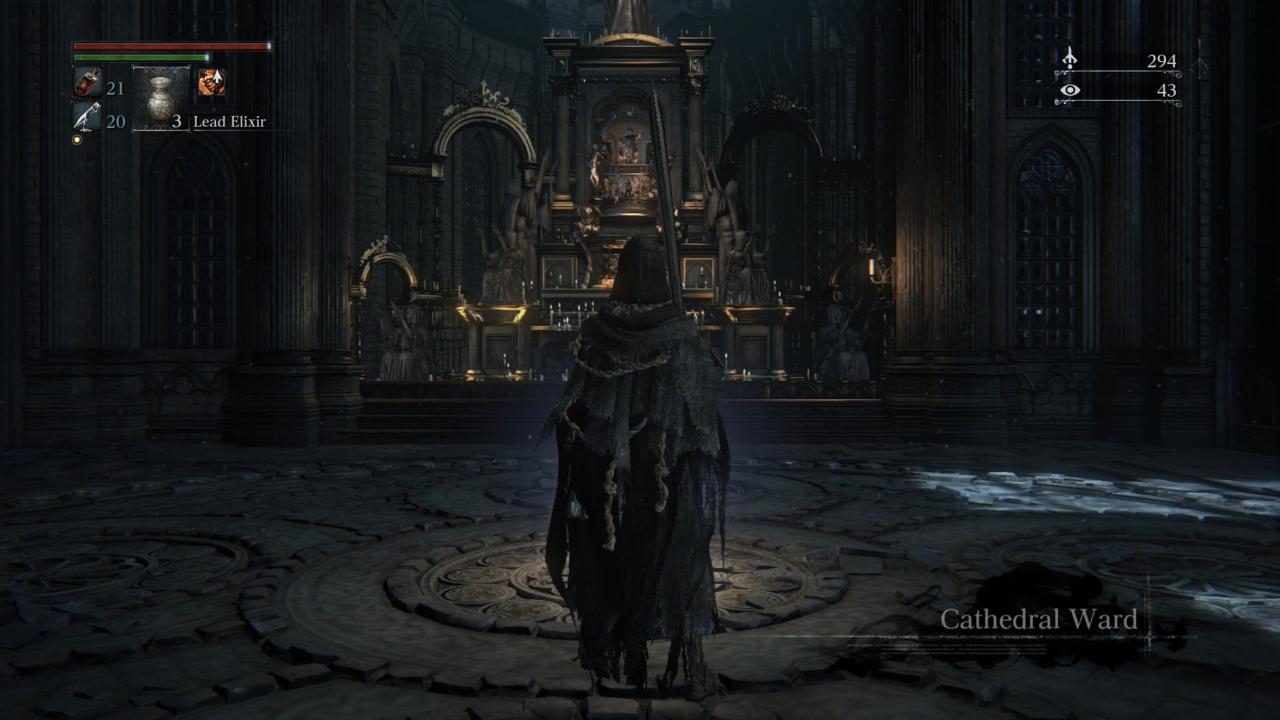
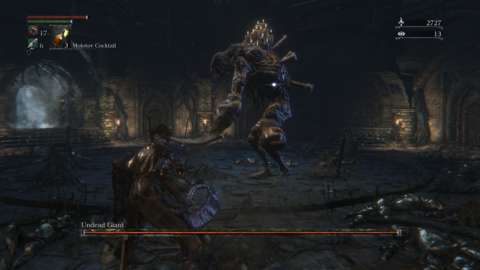

Yet slashing away is a compelling response, due to Bloodborne's health regain system. Should you take damage, you have a limited time to gain some of that lost vitality by landing hits of your own. This system may strike you as incompatible with the rhythms of typical Souls combat, but it's a wonderful fit in Bloodborne for the way it complements not just your own mobility, but that of your enemies. You see, your foes are just as agile--even the hulking gluttons that descend upon you in Boodborne's boss battles. Boss arenas are typically large, affording you plenty of room to escape the wrath of the indescribable horror staring you down--and affording that horror the same luxury. Circle-strafing can no longer be your default strategy when a massive colossus proves more limber than you.
Avoidance is imperative, lest a quartet of mutts tear your flesh apart while leaving you powerless to slash your way out of danger.
These might seem like small adjustments to the formula, but they change the way you apply fundamental skills. For instance, my former lock-on habits no longer led to consistent success--not when a trio of lithe hunters zipped about the boneyard, or when a slobbering monster impossibly leaped through the air and slid across the ground like a chimerical ice dancer. Not only does an energetic enemy make it difficult to keep control of the camera when locked on, but you do not tumble when you are locked onto your target--you only sidestep or backstep. That brute covers more ground in one step than you do in several, so you unlock the camera and rush away, putting the necessary space between you and your quarry.
Other gameplay elements further complement the athleticism. You can carry a firearm in your left hand, for starters, though it makes for a poor offensive tool, not just because it is tuned more for staggering enemies than for damaging them, but because ammunition is a finite resource--you can only carry 20 bullets with you as a rule, and some weapons fire more than one projectile at a time. There is no spell-spamming equivalent in Bloodborne, though a rifle or blunderbuss makes a fine accompaniment to whatever blade you wield in your right hand. That melee weapon, by the way, is transformable. A cleaver is great for doing close, rapid damage, but its secondary mode extends its reach at the cost of speed--and transforming during active battle delivers a third type of attack as the weapon morphs from one state to the other.

There is great flexibility among the available weapons, and when I purchased a new sword from the ghoulish vendor station in Hunter's Dream, I found myself switching between the initial cleaver and the larger alternative, upgrading them both with the bloodstones I looted from certain downed enemies, and further enhancing them with blood gems, another valuable resource. In time, I disregarded firearms and relied on my sword in its two-handed form, transforming when gunmen on ledges and slithering snakes required a different approach. As expected, Bloodborne can be brutal--not as hard as Dark Souls or Demon's Souls, but a step above Dark Souls II in its level of difficulty. Mastery requires properly reacting to enemy behavior, understanding how much space you must put between you and your prey, and knowing when--and when not--to exploit health regeneration.
Bloodborne also takes the survival horror aspects of its close cousins to new heights. Some enemies aren't terrifying just because of their size or their power, but because of the hideous sounds they make, and the shocking entrances that jolt you out of your trance. Crows lurk in corners in groups of four or five, covering the ground with their black wings, and emitting heinous squawks as they thrash about. A deranged disciple breaks through a boarded doorway with a repulsive scream--and what was that figure that just dashed past the doorway ahead? For that matter, what is that monstrosity clinging to the chapel walls whose immense head follows you as you jog past? Bloodborne seeks to disturb you, a goal it succeeds at the first time you cleave a wheelchair-bound gunner.
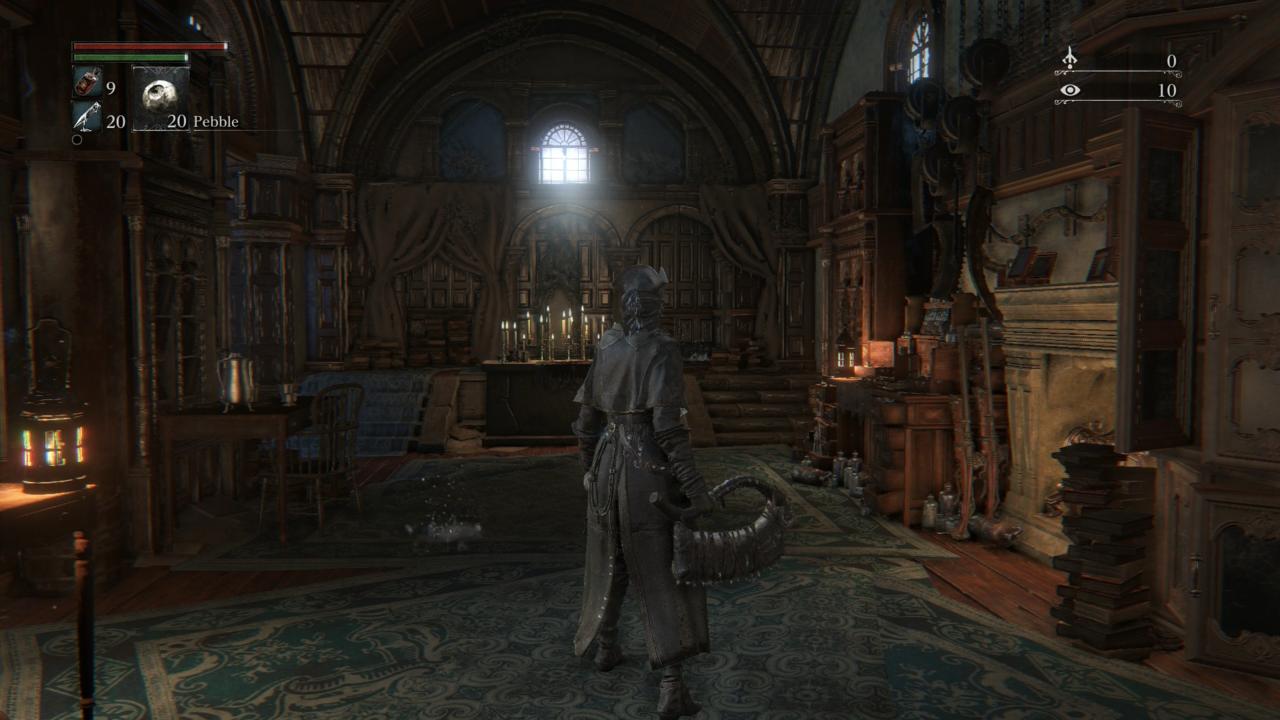


You find quiet and calm in Hunter's Dream, where you stock up on supplies and speak to a living doll who assists you in leveling up while lulling you with her dulcet tones. As in the Souls games, you earn Bloodborne's primary resource by slaying enemies, though instead of gathering souls, you gather blood echoes. In exchange for echoes, the sweet-voiced doll allows you to improve basic attributes. There are fewer such attributes here than there are in Dark Souls, though each one's purpose isn't entirely clear when you begin your adventure. (Don't worry: with time comes understanding.) You can also spend blood echoes on practical items, with blood vials topping the list of necessities. These are your healing draughts, of which you can usually hold 20 at a time, and store 99 others in your stash for safekeeping. Some enemies drop vials when you slaughter them, but Hunter's Dream holds an infinite supply for purchase, so you can go farming for blood if you like, though it isn't strictly necessary.
Some enemies aren't just just terrifying because of their size or their power, but because of the hideous sounds they make, and the shocking entrances that jolt you out of your trance.
Nevertheless, repetition is on the Bloodborne menu, along with the blood of your sworn enemies. (How appropriate, given the game's Biblical subject matter: you drink their blood in remembrance of their sacrifice.) From Software continues to break the rules of video game adventuring to fantastic effect, killing you again and again, and inspiring you to venture into the same territory in hope of regaining the blood echoes that stain the ground where you lost them. You cannot always retrieve them through a stain, however: Sometimes, you must defeat the creature that previously bested you if you want your precious blood echoes returned to you. Otherwise, those echoes are lost to the digital ether--and so the story goes, forcing you to choose whether to press onward and risk losing your souls so you can see the next imposing vista, or to settle for the ones you have and return to Hunter's Dream, and allowing the game to gain the upper hand in your precarious partnership.
There are other partnerships to make. You see other Bloodborne players as spirits roaming in your own world, and can activate grave markers that play back the last few seconds of other adventurers' final moments. In both life and death, other players provide cues to upcoming dangers. Do you notice ghostly figures swinging their weapons with abandon, even when there is no apparent danger? You should reexamine your assumptions: Those apparitions are warning you of imminent attack. You can also drop spectral messages on the ground, alerting other players to traps--and how I wish someone had done so when I stepped on a pressure plate and a sturdy log swung into my face. These aspects of Bloodborne are less novel than they were when they appeared in Demon's Souls, but they are still a vital component of Bloodborne's success, giving rise to a sense of community even when you don't directly interact with other players. You are part of an expansive web of worlds, each one shining a spot of sun into the others.

There are direct interactions in the form of direct cooperation: Ringing the right bell in your inventory either summons a helper into your world, or signals your availability to others. Now that I have finished Bloodborne, this is how I am conquering the new-game-plus: My partner distracts the dreadful Cleric Beast so that I may bury my sword into the creature's flesh. Joining up this way also makes you vulnerable to invasion from other players, a heart-rending twist that has you glancing in multiple directions, looking for signs of the real-life hunter that joins the AI-controlled creatures that hope to end you.
These multiplayer components are also available in Bloodborne's Chalice Dungeons, which are adventuring areas--many of which are procedurally generated--that you enter by performing a ritual at one of Hunter's Dream's available headstones. Standalone dungeons are a neat idea, but you can't enjoy them without caveats. There are specific bosses in there to defeat, such as a humongous flaming watchdog, but if you don't periodically perform new chalice rituals, you can outlevel the ones available to you and breeze through them in a matter of minutes--not much fun in a game whose primary draw is the tension it creates through challenge. I also encountered numerous bugs within, getting stuck in place twice when approaching a glowing orb representing loot to pillage, and running into an issue with boss behavior.
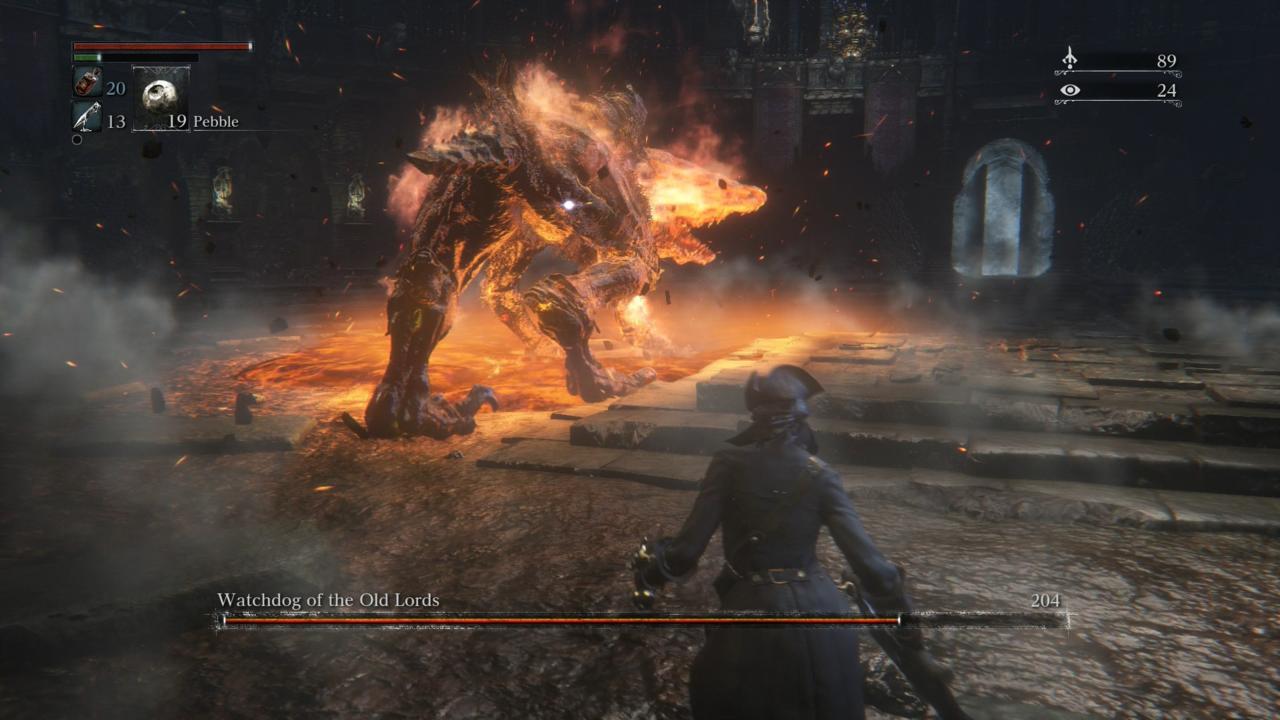
The finest treasures are found within the city of Yharnam and the forests, lakes, and purgatories beyond it. Only Bloodborne would be so bold as to bury an entire factional player-versus-player mechanic within an optional region, which is in turn buried within a series of oblique steps you might miss if you aren't exploring every nook and cranny, or ignore the game's enigmatic hints. I finished Bloodborne in less time than I did Dark Souls II, yet I treasure it more in spite of its few missteps. In death there is life, and in blood, there is redemption. More hyperbole, yes, but for a game this theatrical, only hyperbole will do.